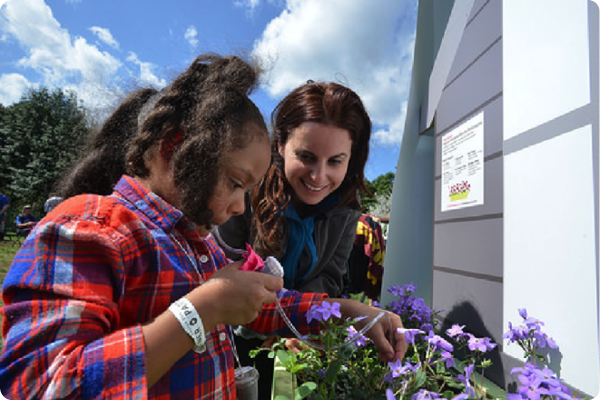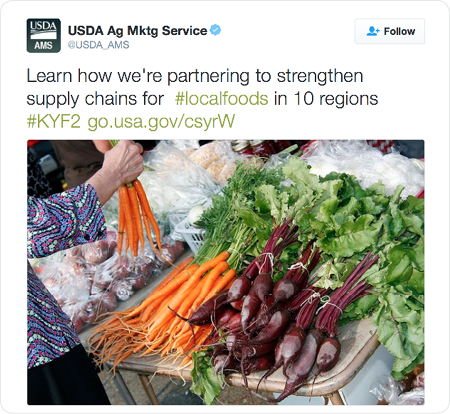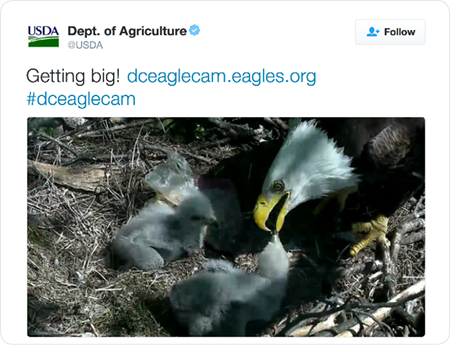USDA In Case You Missed It - #USDAResults: New Markets, New Opportunities
USDA Office of Communications sent this bulletin at 04/04/2016 11:50 AM EDTHaving trouble viewing this email? View it as a Web page.

Today, USDA supports and invests in local and regional food projects from coast to coast, in every state—that was not always the case. When Secretary Vilsack took office in 2009, “local food” was still a relatively new concept. Right out of the gate, USDA gave new priority to giving consumers what they had been asking for: a stronger connection to their food. In April we’ll take a look at how USDA’s programs evolved to support a growing movement to better get to know our farmers, connecting producers with consumers and expanding rural economic opportunities to help more farmers stay on the farm: www.usda.gov/medium.
Addressing the Heroin and Prescription Opioid Epidemic Last week, Agriculture Secretary Tom Vilsack announced a series of upcoming rural town halls as well as funding rural communities can use to conduct health and safety outreach around prescription painkiller and heroin abuse. On your next outdoor adventure, for a memorable and literal walk through history, why not add cultural awareness to the beauty all around you and visit one of the many cultural sites protected by the Forest Service. USDA released SNAP: Nutrition Education and Obesity Prevention Grant Program, the rule which finalizes and fully implements the SNAP nutrition education provisions of the Healthy, Hunger-Free Kids Act of 2010. USDA will ship 500 metric tons of packaged, dry-roasted peanuts grown in the United States to Haiti where the United Nations will distribute the peanuts to school children. White House Fellow Sara Bleich discusses her experiences this year as a Senior Policy Advisor to Under Secretary Kevin Concannon in Food, Nutrition and Consumer Services. New materials developed under USDA’s Team Nutrition initiative offer suggestions for practical ways to keep the whole family healthy during the summer. All of Team Nutrition’s new summer materials are available in English and Spanish. Rural Housing Service Administrator Tony Hernandez talks about the efforts of USDA’s Rural Housing Service (RHS) to increase the number of RHS affordable rental communities participate in in the Food and Nutrition Service’s Summer Food Service Program. Observing trends in U.S. diets is possible based on food-consumption data collected during the annual “What We Eat in America/NHANES” dietary-intake survey. USDA’s Agricultural Research Service (ARS) is responsible for the consumption interview, one of several components of the National Health and Nutrition Examination Survey (NHANES) conducted by the U.S. Department of Health and Human Services. Vicki Lipscomb, President, National CACFP Sponsors Association, discusses the association’s work with USDA to raise awareness across the nation about how USDA’s Child and Adult Care Food Program (CACFP) can help communities address the food insecurity of one in four Americans. Lanon Baccam, USDA Deputy Under Secretary for Farm and Foreign Agricultural Services, serves as the department’s Military Veterans Agricultural Liaison and recently visited Ft. Bliss in El Paso, Texas, as part of the Hiring Our Heroes Transition Summit. USDA’s Expanded Food, Nutrition, and Education Program (EFNEP) has consistently proven its ability to improve the health and well-being of low income families and youth. The program teaches participants how to improve their diets, be more physically active, stretch their food dollars, and increase their knowledge of food safety. FoodShare Columbia, in cooperation with the University of South Carolina and other partners, is revolutionizing the way the community addresses food insecurity. In one of the first-of-its-kind initiatives at an Indian reservation, children at Pine Ridge will have access to supper at Pine Ridge School thanks to the USDA’s Child and Adult Care Food Program (CACFP), which will provide federally-funded meals on the reservation through its At-Risk Afterschool Meals program. It isn’t often that an endangered species successfully recovers, which is why the story of the red-cockaded woodpecker is so inspiring. Once found throughout 90 million acres of longleaf pine forests in the southeast, the red-cockaded woodpecker’s population on National Forest System lands has increased 60 percent from the low of 1,981 active clusters in 1990 to today’s approximately 3,150 active clusters of typically one to five birds each. The new People’s Garden website has tools and resources gardeners can use to start or expand a home, school or community garden, including gardening checklists created in partnership with Let’s Move.
Bringing More Healthful Foods to Corner Stores
Food LINC aims for bumper crop of local foods in Memphis (The Commercial Appeal) Memphis has been chosen to participate in a new federal program that aims to boost the sale of locally produced farm goods and give consumers better access to healthy, locally grown foods. Pueblo is one of 10 communities selected for a federal program that will link farmers with local markets. The U.S. Department of Agriculture is announcing the LINC or Levering Investment for Network Coordination program today, and the Rocky Mountain Farmers Union is among those chosen to participate. U.S. Department of Agriculture (USDA) officials today joined 15 national and regional philanthropic partners to announce a new initiative to bolster the supply chain for local food systems around ten key U.S. cities. The U.S. Department of Agriculture is teaming up with Appalachian Sustainable Development and other organizations around the country to help farmers connect with wholesale retailers. U.S. Agriculture Secretary Tom Vilsack remembers his adoptive mother struggling with alcohol and prescription drug addictions when he was growing up. Vilsack recently shared his story in an exclusive interview with The Atlanta Journal-Constitution as he prepared to speak at a national drug abuse summit in Atlanta Monday. When Mark Isbell, a third-generation rice farmer in central Arkansas, tallies up his profits for this year, he’ll count a few extra dollars from a unique source: the greenhouse gases that his 3,200-acre farm didn’t emit. No matter where we live, from the heartland to the coast, our dreams for our kids and grandkids are simple: that they enjoy long, happy, and healthy lives. But for too many families in rural America, that dream remains out of reach.
|
















![Superheroes come in all sizes at #EasterEggRoll! Bats, [batmen], other pollinators save the for future generations Superheroes come in all sizes at #EasterEggRoll! Bats, [batmen], other pollinators save the for future generations](https://content.govdelivery.com/attachments/fancy_images/USDAOC/2016/04/816823/image11_original.png)
